
| |

| |
| Names | |
|---|---|
| IUPAC name
barium copper yttrium oxide
| |
| Other names
YBCO, Y123, yttrium barium cuprate
| |
| Identifiers | |
| ChemSpider | |
| ECHA InfoCard | 100.121.379 |
| EC Number |
|
PubChem CID
|
|
CompTox Dashboard (EPA)
|
|
| Properties | |
| YBa2Cu3O7 | |
| Molar mass | 666.19 g/mol |
| Appearance | Black solid |
| Density | 6.4 g/cm3[1][2] |
| Melting point | >1000 °C |
| Insoluble | |
| Structure | |
| Based on the perovskite structure. | |
| Orthorhombic | |
| Hazards | |
| GHS labelling: | |

| |
| Warning | |
| H302, H315, H319, H335 | |
| P261, P264, P270, P271, P280, P301+P312, P302+P352, P304+P340, P305+P351+P338, P312, P321, P330, P332+P313, P337+P313, P362, P403+P233, P405, P501 | |
| Related compounds | |
Related high-Tc
superconductors |
Cuprate superconductors |
Related compounds
|
Yttrium(III) oxide Barium oxide Copper(II) oxide |
Except where otherwise noted, data are given for materials in their standard state (at 25 °C [77 °F], 100 kPa).
| |
Yttrium barium copper oxide (YBCO) is a family of crystalline chemical compounds that display high-temperature superconductivity; it includes the first material ever discovered to become superconducting above the boiling point of liquid nitrogen [77 K (−196.2 °C; −321.1 °F)] at about 93 K (−180.2 °C; −292.3 °F).[3]
Many YBCO compounds have the general formula YBa2Cu3O7−x (also known as Y123), although materials with other Y:Ba:Cu ratios exist, such as YBa2Cu4Oy (Y124) or Y2Ba4Cu7Oy (Y247). At present, there is no singularly recognised theory for high-temperature superconductivity.
It is part of the more general group of rare-earth barium copper oxides (ReBCO) in which, instead of yttrium, other rare earths are present.
- ^ Knizhnik, A (2003). "Interrelation of preparation conditions, morphology, chemical reactivity and homogeneity of ceramic YBCO". Physica C: Superconductivity. 400 (1–2): 25. Bibcode:2003PhyC..400...25K. doi:10.1016/S0921-4534(03)01311-X.
- ^ Grekhov, I (1999). "Growth mode study of ultrathin HTSC YBCO films on YBaCuNbO buffer". Physica C: Superconductivity. 324 (1): 39. Bibcode:1999PhyC..324...39G. doi:10.1016/S0921-4534(99)00423-2.
- ^ Cite error: The named reference
:0was invoked but never defined (see the help page).